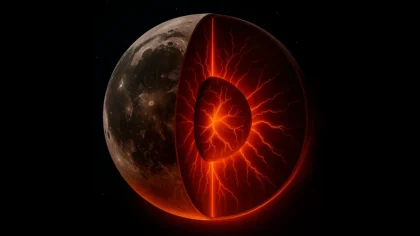We’ve always known that the two sides of the Moon are different. Just look at the side visible from Earth—marked by vast, dark plains—and compare it with the far side, which is more rugged and bright. But now, the difference between the sides of the Moon is no longer just a visual curiosity. It has become a powerful scientific key, revealing how the Moon formed, how it evolved, and why it still bears deep marks of its inner history.
A Discovery Made Without Touching the Lunar Surface
NASA researchers analyzed minute variations in lunar gravity. The data was collected by the Ebb and Flow spacecraft, part of the GRAIL mission. Even without landing, they revealed how the Moon deforms as it orbits Earth. This deformation—called tidal flexing—occurs because of our planet’s gravitational pull.
The strength of this flexing depends on the Moon’s internal structure. This detail allowed scientists to create the most accurate gravitational map of the satellite ever made.
The Far Side Shows Less Movement
What the data revealed surprised the team: the side of the Moon facing Earth deforms more than the far side. This indicates that the Moon’s interior is asymmetric.

Comparison between the near side of the Moon (left) and the far side (right), assembled from images captured by the Lunar Reconnaissance Orbiter. Credit: NASA/JPL-Caltech
According to scientists, this happens because the near side has a warmer mantle region. This area contains radioactive elements that, billions of years ago, heated the Moon’s interior. That heat triggered intense volcanism—the same that formed the lunar maria, seen today as dark spots.
The far side, however, didn’t undergo this process. As a result, it is colder and less flexible.
Why Does This Difference Matter?
Understanding this difference between the sides of the Moon helps answer an old question: why is the satellite so asymmetric? The answer lies in its deep structure. Over billions of years, heat shaped the near side while the far side remained almost untouched.
Furthermore, this discovery shows that it’s possible to explore the interiors of celestial bodies without landing on them. By precisely tracking the orbit of spacecraft and measuring gravitational variations, we unlock new ways to study distant planets and moons safely and efficiently.
A New Chapter in Lunar History
The difference between the sides of the Moon is no longer just a visual detail. It has become a deep record of the Moon’s geological history. Now we know that the near side had a much hotter, more active past—and that this still affects how the Moon behaves today.
This revelation also highlights the power of non-invasive methods. Through gravitational analysis, we can see what lies hidden beneath the surface. From now on, looking at the Moon also means uncovering traces of a fiery past, preserved beneath its silent exterior.
Sources
- NASA/JPL. “NASA Studies Reveal Hidden Secrets About Interiors of Moon, Vesta,” published May 14, 2025.
Explore the Universe
- Perseverance Takes Selfie on Mars and Steals the Spotlight from WALL·E
- Venus Tectonism and What It Reveals About Other Worlds
- What Is the Big Bounce? The Theory of a Universe That Never Stops Restarting
- How Tudum Started at Netflix and Its Evolution
Posts Recomendados
Carregando recomendações...


